
(originally posted 6/28/2021)
Back in 2018, Trevor Bauer stirred some tempers after calling out the Houston Astros for doctoring baseballs with illegal substances during their 2017 World Series run. Those remarks ended up circling back to Bauer when the former Red saw a significant increase in spin on multiple pitches at the end of 2019. On Opening Day, Bauer spun his four seamer at 2,273. By the end of the season, that number had jumped to 2,747 – a 474 RPM increase.
En route to his first career Cy Young award, Bauer spun several pitches from his arsenal at career-high rates in 2020. He paced the league in average spin rate for four seamers (’20: 2,779, ’19; 2,410), curveballs (’20: 2,926. ’19: 2,548), sinkers (’20: 2,780, ’19: 2,343), and cut fastballs (’20: 2,908, ’19: 2,640). His slider spun at 2,951 RPM – a 214 RPM increase from 2019. The adjustments had a noticeable impact on Bauer’s performance. Hitters saw a reduction in batting average against four seamers (.267 to .172), cutters (.312 to .194), and sliders (.186 to .075). His total wOBA decreased from .316 to .227, his strikeout percentage (K%) increased from 27.8% to 36%, and his ERA lowered from 4.48 to a career-best 1.73.

Through 16 starts this season, Bauer currently continues to pace Major League Baseball in average spin for four seamers (2,788) and cutters (2,880). While he’s seen a slight regression from his Cy Young campaign, Bauer has been everything as advertised in his first season donning Dodger blue. He’s won seven games, sports a 2.57 ERA, 1.4 WAR, and leads all Dodger pitchers in innings pitched (101.2), strikeouts (129), and H/9 (5.6).
Now, for the elephant in the room.
Bauer has recently received a ton of criticism for the role he has played in baseball’s notorious battle with spin rate. These criticisms have only been magnified since baseball’s most recent decision to enforce a 10 game suspension for any pitcher caught with foreign substances on the mound. While Bauer hasn’t quite convinced people that his recent increase in average spin was organic, he has been very vocal about his stance on the issue. You can like him, loathe him, or believe he’s a hypocrite. I’m not going to touch on that in here. I’ll leave that issue to Major League Baseball.
What I would like to talk about, however, is something I feel very confident saying: Trevor Bauer is not the same pitcher we all saw enter the league in 2013. He’s not the same pitcher we saw burst onto the scene in 2018 as an AL Cy Young front runner, either. Over the past several years, Bauer has seen a noticeable increase in performance that has solidified him as one of the most challenging at-bats in all of baseball. It has a lot more to do than sticky stuff. Slowly but surely, Trevor Bauer is starting to become the most efficient version of himself on the mound. If people are going to criticize him for his role in baseball’s issue with foreign substances, I think it’s only fair we commend him for the things he’s improved on that have nothing to do with it. We can’t begin to explain his recent increase in performance – or spin rate – unless we do.
Over the next 2,000 words, I’m going to break down the biggest changes I’ve seen with Bauer over the years, why they’ve had a positive impact on his performance, and why I think he’ll continue to perform regardless of spider tack. The improvements we’ve seen from Bauer in regard to spin rate are significant. The way we’ve tried to explain them, however, is incomplete. We’ve become so obsessed with the relationship between the hand and the ball that we’ve forgotten a lot of things need to happen before the hand ever has a chance to impart any force into the ball.
Foreign substances might be turning into baseball’s biggest black eye, but they aren’t the only way to improve how you spin a baseball. This article is my hope to spark some important conversations about this.
If we want to explain Bauer’s recent surge in performance, we have to examine the evolution of his movement signature. He’s obviously changed quite a bit since his UCLA days, but his changes have been as recent as the past several years. I believe it’s had a significant impact on his health and performance.
Below is a video compilation of a pitches he’s thrown from 2018, 2019, 2020, and 2021. Watch the videos and simply make observations the first time through. Pay close attention to the delivery itself, transfer of energy, effort level, and velocity/spin differences. Remember: What you see in his signature will give you insights into what the ball is doing.
For context, below are velocities and spin rates on Bauer’s four seamers from the past four years:
- 2018: 94.5 mph, 2,322 RPM
- 2019: 94.5 mph, 2,410 RPM
- 2020: 93.5 mph, 2,779 RPM
- 2021: 93.8 mph, 2,795 RPM
Let’s see how your observations matched up against mine.
Considering how deliberate Bauer is with his training, it’s very obvious he’s made some conscious changes since first entering the league. For me, the first noticeable change occurs well before he ever throws the ball: He changed his rocker step. Before 2019, Bauer used to step behind the mound with his left leg out of the windup. Now, he simply steps to the side.

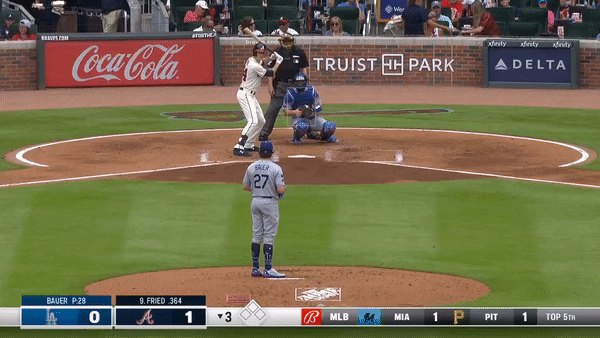
While this change seems innocent, I think it had a noticeable impact downstream. When Bauer used to step behind the rubber, his center of mass would slightly shift away from home plate and towards second base. In other words, he had to go back before he could go forward. It’s not necessarily a delivery killer, but it is a more complex movement. The more complex it is, the more difficult it is to recreate it consistently and effectively. For these reasons, I think Bauer realized that a subtle change here could make a big difference in the rest of his delivery – which it has.
With his simplified rocker step, Bauer doesn’t have to go back to go forward. He took out the negative move and just made it one positive move. As a result, there’s less wasted movement early in the sequence which helps his center of mass get down the mound much more efficiently. When the middle works more efficiently, a lot of other things in the delivery tend to improve. This is where we see another big change with Bauer: His pelvis and trunk are more centered, stable, and connected.
One of the things that made Bauer’s old movement signature unique was the amount of angle he created with his pelvis and trunk after peak leg lift. To give you a feel for this, below is a side shot of his delivery from 2012. I compared it to a video from the side of Gerrit Cole during his breakout 2019 campaign. See how different their angles are as they move down the mound?
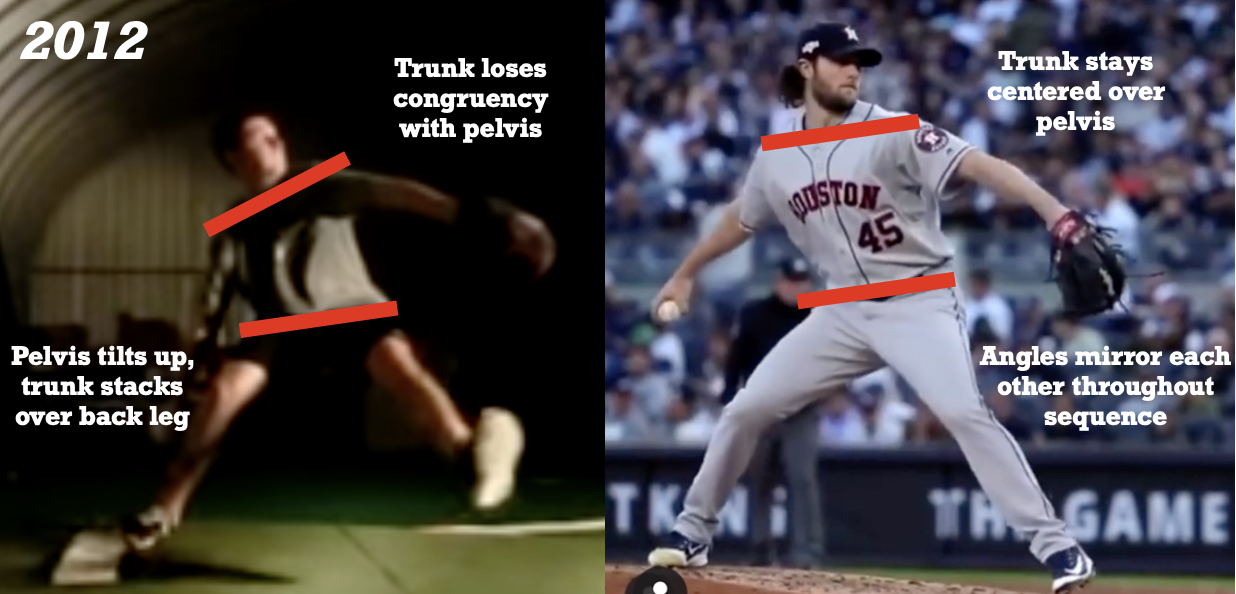
After peak leg lift, the right leg is going to hinge and work slightly underneath the front. This move is commonly referred to as pelvic tilt. We see this move from both Bauer and Cole, but how it interacts with the trunk is where we see a significant difference. I think this lead to a lot of Bauer’s previous inconsistencies.
Think of it like this: Imagine that your trunk is the train and the pelvis is the train tracks. An efficient rotary sequence largely depends on how these two interact with each other. As you can see with Cole, the pelvis and trunk should stay centered between both legs and the angles of both should mirror each other. If the trunk doesn’t match the pelvis or vice versa, you’ve created a disconnection. This is what happens to Bauer. His trunk stacks over his back leg and loses congruency with his pelvis. This puts him in a position where it takes a lot more work to get back down and around the front side into release.
This is also why the initial rocker step could have been really important. Stepping behind the rubber negatively shifts your center of mass away from the plate and makes it more tempting to stack over the back leg. Once this initial domino goes, the rest of the delivery is subsequently impacted. The more complex it is early, the harder it is to sync everything up later.
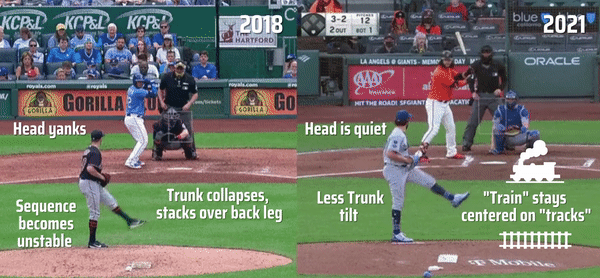
When we look at Bauer in 2021, we see a completely different movement. The train no longer flies off the tracks early. The angle of his trunk mirrors the angle of his pelvis. Everything is much simpler, more connected, and ultimately creates a smoother transfer of energy. Bauer used to work really hard for 95 mph. Now, he can do it with much more ease.
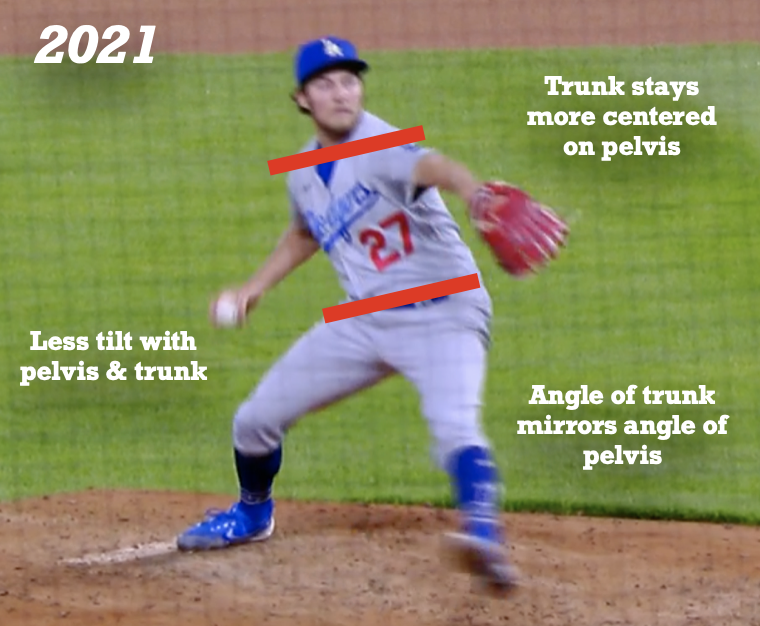
If we continue to go downstream, we see another big adjustment Bauer has made this season: He’s landing slightly more closed. In the past, Bauer’s lead leg would land in line with his back foot at foot strike. Now his lead leg and lead foot land slightly closed in relationship to the back. The adjustment in angles has had a significant difference on his average horizontal release height. In 2018, the average horizontal release for Bauer’s four seamers was 1.40’. That number has jumped in 2021 to a career-high 1.69’.
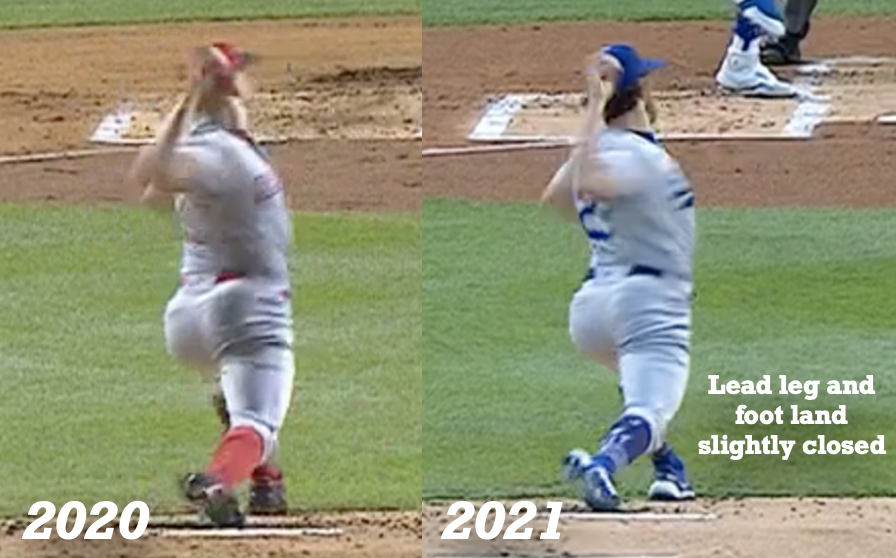
This added angle has also had an impact on Bauer’s deceleration patterns. If we sync up Bauer to release from before and after the adjustment, we notice a big difference in the angle of his torso in relationship to home plate. With his lead leg slightly more closed, Bauer is getting to his point of max crossbody tension (shoulders cross hips) sooner. This is keeping more of his energy directionally towards home.
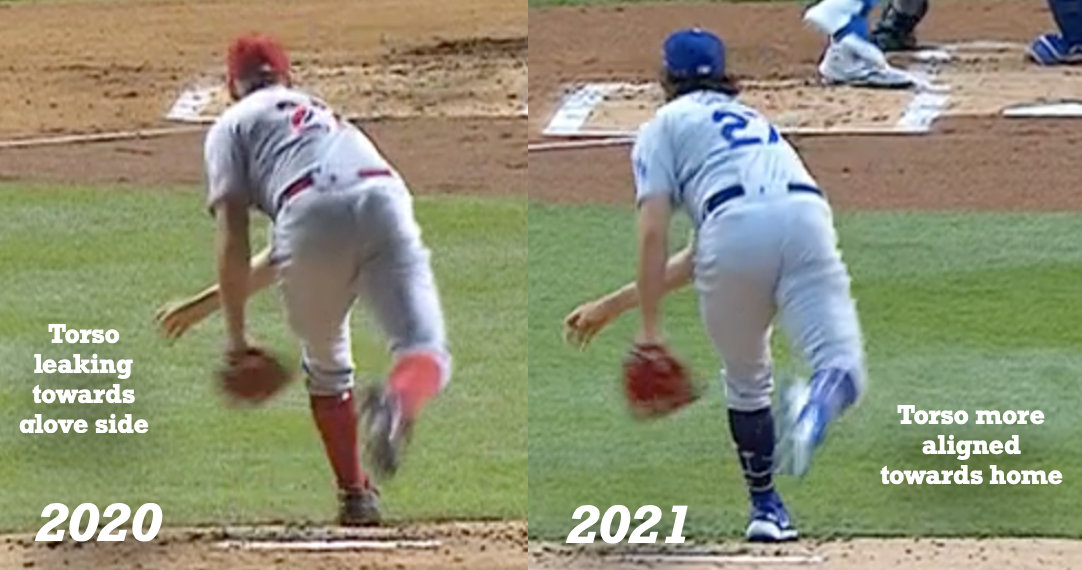
This, in my opinion, has influenced increases in his extension numbers. In 2019, Bauer’s four seamer averaged about 6.2’ of extension. That number has since improved to 6.5’. In ’19, his slider averaged 5.7’ of extension. That number is now 6.4’ – right on par with his four seamer. Landing slightly closed doesn’t mean you’ll automatically add extension, but it does give you the ability to release the ball closer to home without filling up the left handed batter’s box. In Bauer’s case, I think it could have helped.
Positions, however, are only a part of the puzzle. How we capture energy moving through them is equally as important. This, in my opinion, is where Bauer has made the biggest strides. Below is him frame by frame after foot strike and into release from 2018 and 2021:


If we look at the images above, we see Bauer has improved on a number of things in his rotational sequence. His trunk stays closed longer into foot strike. His head is quiet and stays centered over his spine during rotation. Instead of his trunk mismatching planes with the arm, his trunk stabilizes and delivers the arm. At release, the hand, wrist, and elbow all match the shoulder plane. He doesn’t yank or waste energy the way he used to back in 2018. Everything is more stable, connected, and much more energy is getting into the ball at release. It’s much smoother and significantly more efficient.
These all have positive impacts on spin characteristics.
If we go back to my beginning statement, one of the things I mentioned was how spin rate is a lot more than just the relationship between the hand and the ball. The hand is the vessel in which we transmit energy into the ball, but the hand doesn’t create any energy. Our body does. The hand just gives us information about what happened earlier in the sequence. The better the sequencing, the more potential we have to spin the ball. This is why we have to examine the movement signature when we’re looking at differences in spin rate. What you see from the body will give you a good idea for what’s going on at the hand. If we look at Bauer’s evolution, it’s no mistake he’s added over 300 RPM to his fastball over the past six years. He’s eliminated a lot of wasted movement, become much more stable, and he’s capturing rotational energy better than he ever has before. We should, in my opinion, be talking about this a lot more than whatever role he might be playing in “sticky gate.”
His past couple starts, however, have made me slightly worried. Below is a fastball he threw at 92.5 mph from his outing June 18 against Arizona.
While it’s subtle, we can see residue of his old delivery. The transfer of energy isn’t as smooth. His move down the mound isn’t as controlled. His trunk stacks and his arm gets caught working more north to south. On June 6, Bauer’s fastball was averaging 1.8’ of horizontal release angle. That number dropped to 1.5’ his last start. On the season, Bauer’s average release height for four seamers is 5.69’. That number jumped to 5.8’ his last start. While the vertical break on his fastball has remained relatively stable, he’s lost about 2.7” of horizontal movement to the pitch. This is slightly concerning. Knowing Bauer, these changes weren’t an accident. He’s trying to achieve something, but I don’t think he’s trending in the right direction.
It’s something to keep an eye on over his next few starts.
I want to reiterate that I am not going to propose any theories about foreign substances or suggest if any pitcher has been using them or not. Spin rate is still a very new stat that we have a lot to learn about. How Major League Baseball handles the next year will have ripple effects on the game for the next several decades.
Regardless of what they decide to do, I feel very confident saying this: Trevor Bauer will continue to be a really difficult at bat for hitters. The changes he’s made over the past several years will help him pitch in the big leagues for a really long time. I’m very excited to see how he continues to evolve on the mound.
If we’re going to bastardize Bauer for what we think he’s done wrong, we need to give him credit where it’s due.
